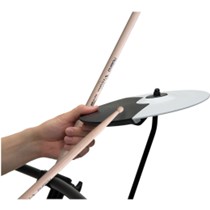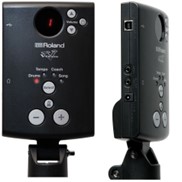This guide aims to provide you with a detailed analysis of all parts of a digital drum set, highlighting the advantages and disadvantages compared to acoustic sets. It will also offer guidance on what to consider when purchasing a digital drum set. Our guide extends over multiple pages, with each thematic section accessible through the table of contents on the right side of this page.
Question: Acoustic Set or Digital?
Answer: Both. It depends on what you want to do. A digital set can do things that an acoustic set cannot, and vice versa. So, what is the difference in electronic drums, and what makes them stand out?
Sound:
The sound in an electronic set is produced by the drum module, the central console – the “digital brain” that can reproduce up to 1000 sounds from various acoustic and electronic instruments, which can be customized to your liking. This adaptability makes electronic sets suitable for genres such as techno, dance, or R’n’B, which rely on electronic sounds, an area where digital drum sets excel. High-quality electronic drums now offer incredibly realistic acoustic sounds that can compete with those of traditional sets. On the other hand, some music styles require the physical acoustics and dynamics that only acoustic sets can provide.
Space:
A digital set requires less space than an acoustic one. This is important when you have limited space available, such as a small room, an office, or a child’s room. A digital set can be easily set up, disassembled, folded, and stored near a wall or in a cabinet. The electronic drum set has a clear advantage here!
Noise
Digital drum sets do not have conventional membranes and therefore produce less noise than acoustic sets due to their elastic playing surface. This is a huge advantage for practicing in an apartment compared to an acoustic drum set! Being able to practice anytime you want without disturbing those around you is essential for your progress and the availability of the set, as a digital drum set can better meet these needs.
Possibilities:
With the press of a button, electronic drums provide you access to hundreds of sounds and settings, making them ideal for daily use where time is precious. You no longer have to worry about volume being too loud or too weak on stage, as you can easily adjust it on the mixer. And let’s not forget the studio – goodbye to the hassle of placing microphones correctly, welcome to ultimate sound control. Electronic drums save time and facilitate recording. Of course, the sound of an acoustic drum set is significantly influenced by the environment in which it is played. When it is in a room with excellent acoustics, it can be exceptional inspiration!
Installation - Assembly
The process of installing a digital drum set may seem challenging, but with the right approach, it can be quite easy. Usually, an illustrated assembly manual is provided with each set, making it easier for you to enjoy your new digital drum set.
Components of a Digital Drum Set
Pads – Playing Surfaces
While earlier electronic drum sets featured rubber playing surfaces, in recent years, even entry-level models have gradually adopted the use of membranes, also known as “mesh heads.” These provide a slightly softer feel that is more wrist-friendly and closer to an acoustic set, making them more versatile for various playing styles. Additionally, they are adjustable in terms of tension and significantly quieter on impact compared to rubber. Drummers with wrist issues may prefer rubber pads due to the more solid playing surface. In this case, they could also consider using low-impact drumsticks, such as those offered by Zildjian, to reduce friction on the wrist.

Pedals
For a more authentic playing experience, it is recommended to use a pedal base that is positioned vertically and features a rubber or membrane surface, functioning like a conventional kick drum pedal. Most bases also support the use of a double bass pedal. More budget-friendly digital drum sets usually come with pedals that have integrated sensors or triggers in their base, but these may not provide the same playing feel as a “real” kick drum pedal.
Cymbal Pads
There are specially designed pads or playing surfaces for cymbals, primarily made of rubber in various shapes. Cheaper electronic drum sets may have two-zone sensitivity for cymbals, while higher-end sets often use pads with three sensitivity zones (rim, pad, cup) that can be played across their entire surface, offering different sounds with a better and more authentic playing feel.

Hi-Hat
In simpler digital drum sets, a sensor is connected to a pedal through the central console, which electronically controls the “openness” of the hi-hat. The sound changes based on the position of the pedal. More sophisticated sets use a mechanism that takes over the entire hi-hat operation with greater precision. Such a mechanism can open and close the hi-hat just like in an acoustic drum set. Modern digital drum sets can now offer high-quality sounds and an almost authentic playing feel with good dynamics and tonal range.
Rack Stand
In most electronic drum set series, the rack to which all parts of the set are connected is a crucial element. The rack of an electronic drum set should be compact and durable due to its smaller size. More professional sets may have more components and a rack that resembles that of an acoustic set or even regular stands for cymbals, just like in an acoustic drum set.
The most common racks for digital drum sets are easy to assemble and take up little space. Many manufacturers provide a clever way to hide the connection cables of the module and pads inside the rack’s tubing. This is a significant advantage, as you won’t have to worry about losing or damaging the cables, and the set will look much cleaner and more organized. Like acoustic sets, most digital sets can be expanded with the addition of extra pads.
Drum Module
The heart, or rather the brain, of a digital drum set is the drum module. A set can sound and perform only as well as its drum module allows. The quality of the module depends not only on the quality of the built-in sounds but also on the ability to add your own samples to many modules. This becomes evident when trying a fast roll on the drum/snare. In cheaper modules, the sound is often sterile and uniform. In the worst case, the same sound is heard at different intensity levels, which is not true to reality because a soft hit on the drum/snare has a completely different sound profile from a loud one. The number of intensity levels is also often limited in simpler modules.

Most modules often feature educational functions to improve rhythm and monitor your progress. Many modules also offer various effects such as ambience, echo, or reverb to refine their sounds. Only a limited number of reputable manufacturers currently produce modules and digital drum sets for the European market, with Roland leading the way and Donner being the ideal solution in the budget categories for beginner students.
Prices
The prices of digital drum sets can vary significantly, ranging from around 300 euros to 8000 euros. As a beginner, it’s advisable to focus on the lower end of the spectrum, up to a maximum of 800 euros. However, don’t let the price deceive you – there are models priced around 400 euros that offer a genuine experience with mesh head pads, multi-zone cymbals, and a kick pedal. These features are essential for learning different techniques and maximizing your practice. While the sounds of these affordable kits may not satisfy very high demands, they often provide a variety of acoustic and electronic sounds, as well as educational functions to improve your skills.
Conclusion
Electronic drum sets are the real solution! For those who want to maintain a low “acoustic” profile without disturbing others during practice, digital sets provide the ideal solution for space-saving and noise reduction for home training at any time of the day. Moreover, if you’re looking for some inspiration in your practice routine, many affordably priced sets feature educational functions that will help you develop your skills. Before making a purchase, it’s worth checking if the digital set you’ve chosen can be connected to a computer for easy sound upgrades to keep your interest “fresh” when you get tired of the built-in sounds.
Mid-range kits are more flexible, offering significantly more in terms of sound and features compared to low-end models. The connectivity options they have allow them to easily integrate into a live or studio setup. The ability to import custom sound samples means you can easily achieve a unique sound that truly represents your style.
For those who want to take it a step further, top-tier digital drum sets offer sound quality that rivals that of acoustic sets. Some of these sets may have a hefty price tag, but don’t be afraid, as they provide exceptional authenticity and high-quality sound. These sets are perfectly suitable for live performances on stage! They offer a variety of inputs and outputs that allow for better sound processing at the mixer, making them the most flexible choice for any live performance. And, to complete the picture, some models even look so much like acoustic sets that you might not even distinguish the difference!




